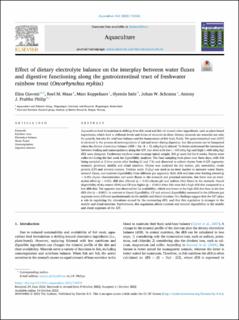| dc.description.abstract | Aquaculture feed formulation is shifting from fish meal and fish oil toward other ingredients, such as plant-based ingredients, which lead to different levels and forms of minerals in diets. Dietary minerals are essential not only for growth, but also for acid-base balance and the homeostasis of fish body fluids. The gastrointestinal tract (GIT) is involved in the process of osmoregulation of salt and water during digestion, but this process can be hampered when the dietary electrolyte balance (dEB = Na - K + Cl, mEq/kg) is altered. To better understand the interaction between feeding and osmoregulation along the GIT, two diets with low (−100 mEq/kg) and high (+600 mEq/kg) dEB were designed. Freshwater rainbow trout (average initial weight, 306 g) were fed for 6 weeks. Faeces were collected during the last week for digestibility analyses. The final sampling took place over three days, with fish being sampled at 2 time points after feeding (3 and 7 h) and dissected to collect chyme from 4 GIT segments: stomach, proximal, middle and distal intestine. Chyme was analysed for dry matter, pH, osmolality, crude protein (CP) and mineral content. Yttrium oxide (Y2O3) was used as an inert marker to measure water fluxes, mineral fluxes, and nutrient digestibility from different gut segments. Both dEB and time after feeding altered (p < 0.05) chyme characteristics and water fluxes in the stomach and proximal intestine, but there was no interaction effect (p > 0.05). dEB also affected (p < 0.01) chyme pH and sodium (Na) fluxes in the stomach. Faecal digestibility of dry matter (DM) and CP was higher (p < 0.001) when fish were fed a high dEB diet compared to a low dEB diet. The opposite was observed for Ca availability, which was lower at the high dEB diet than at the low dEB diet (p < 0.001). In contrast to faecal digestibility, CP and mineral digestibility measured in the different gut segments were different predominantly in the middle and distal intestine. Our findings suggest that the GIT plays a role in regulating the alterations caused by the contrasting dEB, and that this regulation is stronger in the middle and distal intestine. Furthermore, this regulation affects nutrient and mineral digestibility in the middle and distal segments of the GIT. | |
